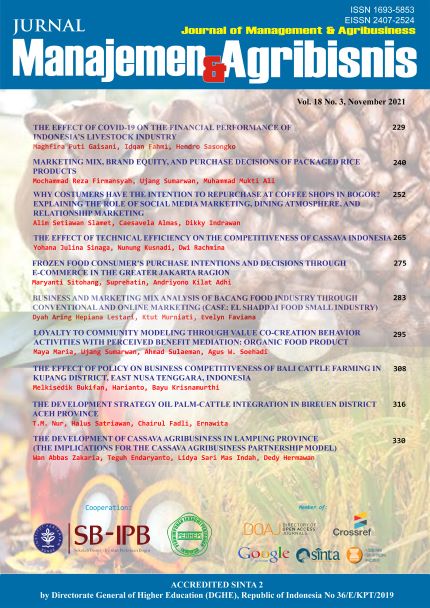The Development Strategy Oil Palm-Cattle Integration in Bireuen District Aceh Province
Abstract
Environments in which oil palms grow involve some components and production resources crucial in increasing the development of integrated palm oil plantation systems without damaging the environment. This study aimed to determine strategies and direction of the development of oil palm-cattle integration and improve the regional economy. The primary data were obtained through questionnaires by interviewing 50 respondents, which comprised cattle farmers and experts /stakeholders of Almuslim University and STIE Kebangsaan Bireuen and local government agencies directly involved with the study topics. AHP and SWOT were used to analyze oil palm-cattle integration strategy development data. The main findings of the study require main strategies: 1) Increasing the efficiency of oil palm-cattle integration from extensive to intensive model with the support of stakeholders; 2) Creating an effective and successful pilot cattle farmer groups in carrying out oil palm-cattle integration by utilizing cheap and nutritious feed from oil palm plantations; 3) Utilizing cow dung as fertilizer and biogas as a source of income for farmers; 4) Expanding cattle farmer's knowledge on the development of beef cattle population and livestock health services; 5) Increasing active government participation in facilitating cattle and oil palm farmers in integration implementation, and 6) Utilizing financial institutions/banking services to increase business capital which will aid in increasing beef cattle population and oil palm production.
Keywords: AHP-SWOT, plantation, stakeholders, oil palm, cattle
Authors
Authors who publish with this journal agree to the following terms:
- Authors retain copyright and grant the journal right of first publication with the work simultaneously licensed under a Creative Commons Attribution License that allows others to share the work with an acknowledgement of the work's authorship and initial publication in this journal.
- Authors are able to enter into separate, additional contractual arrangements for the non-exclusive distribution of the journal's published version of the work (e.g., post it to an institutional repository or publish it in a book), with an acknowledgement of its initial publication in this journal.
- Authors are permitted and encouraged to post their work online (e.g., in institutional repositories or on their website) prior to and during the submission process, as it can lead to productive exchanges, as well as earlier and greater citation of published work (See The Effect of Open Access).

